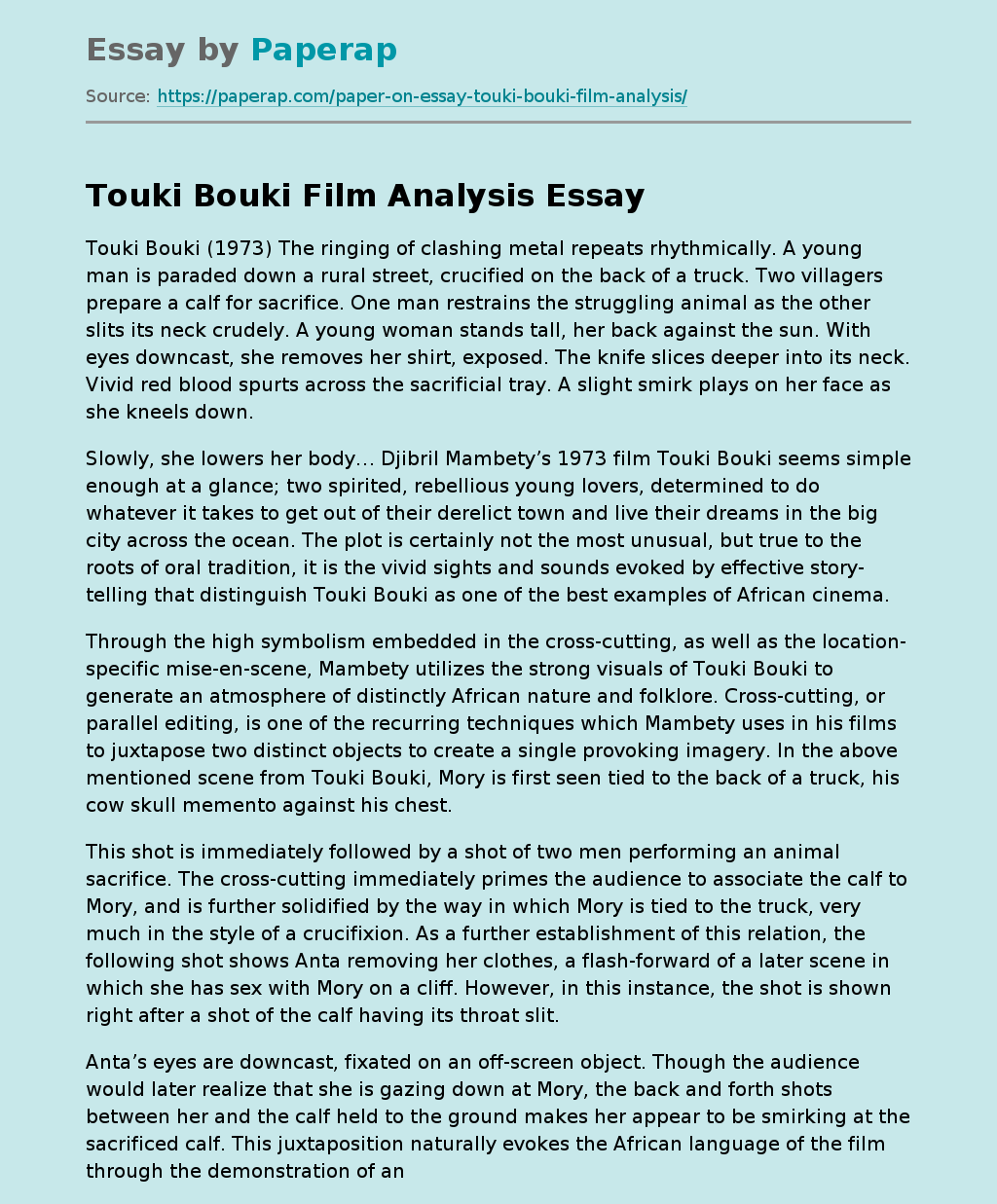Touki Bouki Film Analysis
The following sample essay on Touki Bouki Film Analysis (1973) The ringing of clashing metal repeats rhythmically. A young man is paraded down a rural street, crucified on the back of a truck. Two villagers prepare a calf for sacrifice. One man restrains the struggling animal as the other slits its neck crudely. A young woman stands tall, her back against the sun. With eyes downcast, she removes her shirt, exposed. The knife slices deeper into its neck. Vivid red blood spurts across the sacrificial tray.
A slight smirk plays on her face as she kneels down.
Slowly, she lowers her body… Djibril Mambety’s 1973 film Touki Bouki seems simple enough at a glance; two spirited, rebellious young lovers, determined to do whatever it takes to get out of their derelict town and live their dreams in the big city across the ocean. The plot is certainly not the most unusual, but true to the roots of oral tradition, it is the vivid sights and sounds evoked by effective story-telling that distinguish Touki Bouki as one of the best examples of African cinema.
Through the high symbolism embedded in the cross-cutting, as well as the location-specific mise-en-scene, Mambety utilizes the strong visuals of Touki Bouki to generate an atmosphere of distinctly African nature and folklore. Cross-cutting, or parallel editing, is one of the recurring techniques which Mambety uses in his films to juxtapose two distinct objects to create a single provoking imagery. In the above mentioned scene from Touki Bouki, Mory is first seen tied to the back of a truck, his cow skull memento against his chest.
This shot is immediately followed by a shot of two men performing an animal sacrifice. The cross-cutting immediately primes the audience to associate the calf to Mory, and is further solidified by the way in which Mory is tied to the truck, very much in the style of a crucifixion. As a further establishment of this relation, the following shot shows Anta removing her clothes, a flash-forward of a later scene in which she has sex with Mory on a cliff. However, in this instance, the shot is shown right after a shot of the calf having its throat slit.
Anta’s eyes are downcast, fixated on an off-screen object. Though the audience would later realize that she is gazing down at Mory, the back and forth shots between her and the calf held to the ground makes her appear to be smirking at the sacrificed calf. This juxtaposition naturally evokes the African language of the film through the demonstration of an African ritual sacrifice, but with the inclusion of Mory, as an impoverished, suffering citizen, it not only shows the traditional aspects of African culture, but also sets an undertone of the problems with modern African culture.
Besides cross-cutting, the mise-en-scene of Touki Bouki is another prominent aspect of the film which provides a strong sense of the African identity. Following the sequence of juxtapositions of Mory, the calf, and Anta, the transition into the next scene is facilitated by a shot of the now dead calf, being skinned and cleaned by Anta’s aunt. In one distinctly provoking scene, Anta is seen running away from her crazed, cackling aunt, while the carcass of the calf sways in the foreground. The land around them, like all other parts of the inhabited areas, is dusty and almost barren, save for a few dry, twig-like plants.
The living conditions of the village are still considerably primitive, stark contrasts to the extravagant lifestyle of well-off people like Mory’s effeminate acquaintance, ‘Charlie’. Besides the barren lands, another recurring location is the ocean. Throughout the film, there are many inserted shots of waves crashing against rock, at times disrupting the continuity of the scene. The significance of the ocean can be seen in the scene following Anta’s running from her aunt; as the mood of the film intensifies, the waves start to crash more heavily against the rocks.
Throughout the whole film, Mory and Anta are on a quest to escape from Dakar, always heading towards the direction of the sea. The constant presence of the ocean reinforces Mory and Anta’s constant persistence to reach the land beyond the ocean. With the dry dessert lands, villages, cliffs and crashing waves, as well as vehicles, buildings, and Charlie’s swanky bachelor pad, the mis-en-scene makes the film distinguishably African, and similar to the cross-cutting, establishes the contrast between post-colonial Africa’s rich and poor.
Djibril Mambety once said that he “[felt] that a filmmaker must go beyond the recording of facts…one searches for an African film language that would exclude chattering and focus more on how to make use of visuals and sounds. ” Evidently, these sentiments were well-expressed through his story-telling of Touki Bouki. With the use of unorthodox sound effects and vivid, graphic visuals, Mambety, in exemplary traditional African fashion, conveyed the tension between Africa’s past and future with music and color.
As seen in his use of cross-cutting and mis-en-scene, with the presence of provoking imagery, dialogue need not drive a convincing film. With the use of sight and sounds, Mambety’s Touki Bouki has its own uniquely African voice which rings louder than the loudest of Aunt Oumy’s cackles. Works Cited Touki Bouki. Dir. Djibril Diop Mambety. Perf. Magaye Niang, Mareme Niang, Aminata Fall. Cinegrit, Studio Kankourama, 1973. Youtube. Web. 05 Mar. 2011. <http://www. youtube. com/watch? v=b1IZvmjveT0>.
Touki Bouki Film Analysis. (2019, Jun 20). Retrieved from https://paperap.com/paper-on-essay-touki-bouki-film-analysis/

